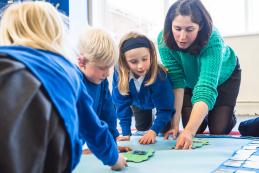Differentiating Literacy Teaching for Diverse Learners
As educators, we must understand the diverse needs of our learners. In every classroom, we encounter pupils with varying backgrounds, abilities, and learning styles. To provide effective literacy teaching, we must embrace differentiation and tailor our teaching to meet the unique needs of each child. This blog post will explore the importance of differentiating teaching for diverse learners and provide practical strategies for creating inclusive and supportive learning environments.
Understanding Diverse Learners
 Every child brings their own set of strengths, challenges, and experiences to the classroom. By understanding the diverse needs of our learners, we can better support their literacy development. This means considering factors such as language proficiency, cultural background, learning disabilities and individual learning preferences. By recognising and valuing these differences, we can create a classroom environment where all pupils feel seen, heard, and valued.
Every child brings their own set of strengths, challenges, and experiences to the classroom. By understanding the diverse needs of our learners, we can better support their literacy development. This means considering factors such as language proficiency, cultural background, learning disabilities and individual learning preferences. By recognising and valuing these differences, we can create a classroom environment where all pupils feel seen, heard, and valued.
When we understand our pupils' unique needs, we can adapt our teaching strategies, materials and assessments to better cater to their individual learning styles. For example, providing visual aids, using manipulatives, or incorporating technology can help pupils who are visual or kinesthetic learners. By offering a variety of teaching approaches, we can engage and motivate diverse learners, ultimately leading to improved literacy outcomes.
Differentiating Teaching
Differentiating teaching involves modifying and tailoring our teaching methods to meet the needs of diverse learners. This can be done in several ways. Firstly, we can vary the level of complexity in our teaching materials. By providing different reading levels or offering alternative texts that align with pupils' interests, we can ensure that all pupils have access to appropriate content.
 Secondly, we can provide flexible grouping strategies. This means grouping pupils based on their specific needs and abilities, rather than relying solely on year group or age. By creating small, targeted groups, we can provide more personalised teaching and support.
Secondly, we can provide flexible grouping strategies. This means grouping pupils based on their specific needs and abilities, rather than relying solely on year group or age. By creating small, targeted groups, we can provide more personalised teaching and support.
Another effective strategy is providing multiple means of representation. This involves presenting information in different formats, such as visual aids, audio recordings, or hands-on activities. By offering multiple pathways to understanding, we can accommodate diverse learning styles and preferences.
Finally, it is important to differentiate assessments. Traditional assessments, such as written tests, may not accurately reflect the knowledge and skills of all learners. By incorporating alternative assessments, such as projects or presentations we can provide pupils with different ways to demonstrate their understanding.
Creating Inclusive Learning Environments
 Inclusive learning environments are crucial for supporting diverse learners. An inclusive classroom embraces diversity and promotes a sense of belonging for all pupils. This can be achieved by creating a positive and respectful classroom culture, where all voices are heard and valued.
Inclusive learning environments are crucial for supporting diverse learners. An inclusive classroom embraces diversity and promotes a sense of belonging for all pupils. This can be achieved by creating a positive and respectful classroom culture, where all voices are heard and valued.
Teachers can foster inclusivity by incorporating diverse literature and resources that reflect the backgrounds and experiences of their pupils. This not only validates pupils' identities but also helps to broaden their perspectives and develop empathy.
Furthermore, it is important to establish clear expectations for respect and inclusion and to address any instances of bias or discrimination promptly. By modelling inclusive behaviour and addressing issues as they arise, we can create a safe and supportive learning environment for all pupils.
Collaboration and Support
 Collaboration is key in meeting the diverse needs of our learners. By working together with colleagues, parents, and specialists we can gain valuable insights and support for differentiation.
Collaboration is key in meeting the diverse needs of our learners. By working together with colleagues, parents, and specialists we can gain valuable insights and support for differentiation.
Colleagues can provide a wealth of knowledge and expertise. By sharing strategies, resources, and experiences, we can learn from one another and enhance our teaching practices. Collaborating with colleagues also allows us to pool our resources and support the needs of diverse learners more effectively.
Parents and guardians are important partners in supporting pupils' literacy development. By involving parents in the educational process and seeking their input, we can better understand pupils' strengths, challenges, and individual learning needs. Building strong home-school partnerships is essential for ensuring a consistent and supportive learning experience for diverse learners.
Finally, specialists such as educational psychologists, speech and language therapists, and special education teachers can provide valuable insights and interventions for pupils with specific learning needs. By seeking their guidance and collaborating with them, we can better support diverse learners and provide targeted interventions as needed.
Enhancing Instruction with Technology
Technology and multimedia resources can greatly enhance literacy teaching for diverse learners. Digital tools and platforms offer opportunities for interactive and engaging learning experiences.
For example, pupils can use educational apps or websites to practice reading, writing and language skills. These tools often provide immediate feedback and personalised learning paths, allowing pupils to work at their own pace and level.
Additionally, technology can provide access to a wide range of texts and resources, including audiobooks, e-books, and videos. This accessibility is especially beneficial for pupils with reading difficulties or visual impairments.
Promoting Choice and Self-Expression
Providing opportunities for choice and self-expression is essential for fostering motivation and ownership in literacy learning. Allowing pupils to choose their own topics, genres, or formats for writing assignments can increase engagement and investment in the task.
Furthermore, encouraging pupils to express their ideas and opinions through writing, whether it be through personal narratives, persuasive essays, or creative stories, promotes self-expression and voice. This can be especially empowering for diverse learners who may have unique perspectives and experiences to share.
Assessment and Individualised Support
 Regular assessment and monitoring of progress are crucial in differentiating teaching and providing individualised support. By assessing pupils' skills and knowledge we can identify areas of strength and next steps.
Regular assessment and monitoring of progress are crucial in differentiating teaching and providing individualised support. By assessing pupils' skills and knowledge we can identify areas of strength and next steps.
Formative assessments, such as observations, can provide valuable insights into pupils' understanding and progress. These assessments can inform decisions and help teachers tailor their teaching to meet individual needs.
Additionally, summative assessments, such as unit tests or projects, can provide a comprehensive snapshot of pupils' learning. By analysing assessment data, we can identify areas where pupils may need additional support or enrichment.
Empowering Pupils through Scaffolding
Scaffolding is a powerful instructional technique that supports diverse learners in acquiring new skills and knowledge. By providing structured support and gradually releasing responsibility to the pupils, we empower them to become independent learners.
Scaffolding can take many forms, such as providing graphic organisers, sentence starters, or model texts. These tools help pupils organise their thoughts and guide them through the writing process.
Celebrating Diversity and Cultural Backgrounds
 Finally, it is important to celebrate diversity and cultural backgrounds in literacy teaching. By incorporating diverse literature, stories, and perspectives, we can promote inclusivity and help pupils develop a sense of self-identity.
Finally, it is important to celebrate diversity and cultural backgrounds in literacy teaching. By incorporating diverse literature, stories, and perspectives, we can promote inclusivity and help pupils develop a sense of self-identity.
Teachers can create opportunities for pupils to share their cultural traditions, stories, and experiences. This not only enriches the learning environment but also fosters a sense of pride and belonging.
Differentiating literacy teaching for diverse learners is not just an important educational practice, but also a powerful way to create inclusive and engaging learning environments. By understanding the unique needs of our pupils, adapting our teaching strategies, and collaborating with others, we can ensure that all learners succeed in literacy.
By embracing differentiation, we can empower our pupils to become confident and skilled readers and writers and celebrate the diversity that makes each learner unique.
How Can Mighty Writer Help?
Mighty Writer (primarily designed for key stage one literacy teaching) engages all types of learners in the way it is designed and used. It allows children to become confident and accomplished writers, supporting, challenging and motivating them along the way.
It does this in 5 key ways...
